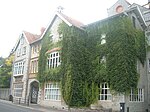Millfield
Millfield is a public school (English fee-charging boarding and day school for pupils aged 13–18) located in Street, Somerset, England. It was founded in 1935. Millfield is a registered charity and is the largest co-educational boarding school in the UK with approximately 1,200 students, of whom over 900 are full boarders of over 70 nationalities. Millfield Development and the Millfield Foundation raise money to fund scholarships and bursaries. The school is a member of the G20 Schools Group and a member of the Headmasters' and Headmistresses' Conference. The Millfield campus is based over 240 acres in Somerset, in and around Street, in the South West of England. Millfield has its own pre-prep and preparatory school, Millfield Preparatory School (also known as Edgarley) in nearby Glastonbury, which takes children from 2 to 13 years old. The prep school shares some of Millfield's facilities. It acts as a feeder school, with over 90% of its pupils typically moving up to Millfield each year.
Excerpt from the Wikipedia article Millfield (License: CC BY-SA 3.0, Authors).Millfield
Butleigh Road,
Geographical coordinates (GPS) Address Phone number Website External links Nearby Places Show on map
Geographical coordinates (GPS)
| Latitude | Longitude |
|---|---|
| N 51.1225 ° | E -2.7275 ° |
Address
Millfield School
Butleigh Road
BA16 0YD
England, United Kingdom
Open on Google Maps








